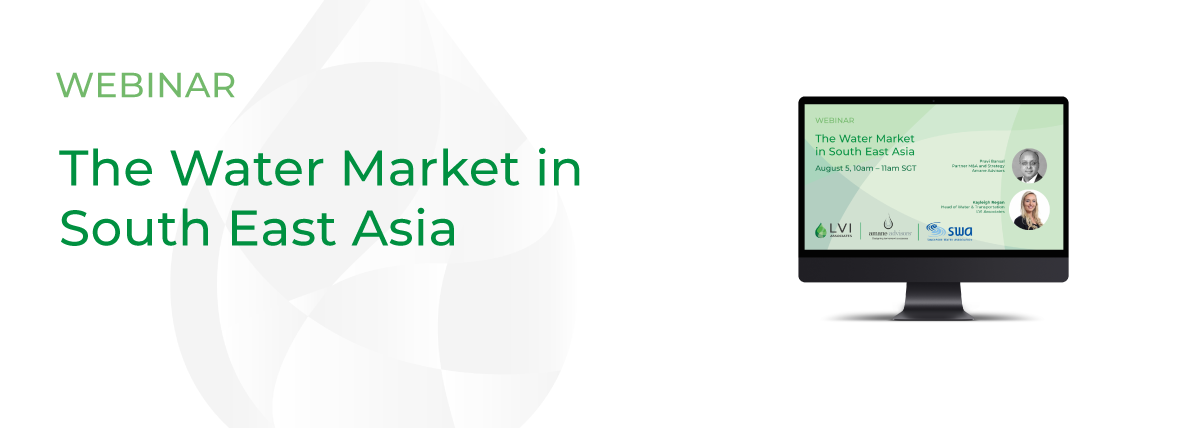On 5th August, Singapore Water Association (SWA) co-organised the latest webinar with LVI Associates, “The Water Market in South East Asia”. More than 100 participants attended the webinar.
During the course of the webinar, our highly engaged audience asked pressing interesting questions about developments affecting the water market.
Ms Kayleigh Regan, Head of Water & Transportation at LVI Associates and Mr Pravi Bansal, Managing Partner at Amane Advisors - South East Asia have shared their insights.
Market Outlook
Do you expect industry consolidation given market slowdown?
Yes. In our analysis of COVID’s impact on water investments, we have also anticipated that it is the optimal time for larger corporates to look for the tuck-ins which would help strengthen product portfolio, customer access or geographic reach.
What is the impact of evolving circular economy concept affecting the water industry?
We are already seeing the material impact in water hydration markets with players looking to get away from plastics use.
Furthermore, we expect to see increased growth of bottle-free water coolers in the residential and commercial segments.
What is the market value and potential capacities for the water business in Vietnam? Both in the municipal water supply and waste water plus the opportunities in industrial wastewater?
Vietnam has had a sharp increase in the capacity and coverage of both its water and wastewater infrastructure.
Wastewater management has moved up the political agenda, with new regulation and a federal government goal to achieve full coverage for wastewater collection and treatment in major cities by 2025. For industrial, opportunities are driven by the US-China trade war with growth in industrial parks as well as textile/garments industry for example. Vietnam has steadily introduced environmental laws and regulations to control pollution from industrial facilities, driving the market for wastewater treatment.
According to Global Water Intelligence, the municipal water CAPEX market is worth ~$500m in 2020 and ~$330m for wastewater, while industrial water and wastewater CAPEX is estimated to be ~$90m.
Do you see the governments in these markets being as effective as China in enforcing wastewater treatment regulations both in the municipal and industrial sector in the near future?
China has one of the most stringent and it will take significant time and effort for the less developed countries in Southeast Asia to reach the same level of enforcement and compliance, especially as the sector is much less mature with spending and resources prioritised for building infrastructure rather than on increasing treatment to meet wastewater discharge regulations, for example. India is the next country to look at in terms of strict enforcement of regulations, and they are progressing a few years behind China in general, with strong efforts now to strengthen enforcement of wastewater standards.
What is the outlook of recycling and reuse market in the Malaysia and Indonesia region? Will it have the potential in the near future? (Considering the low cost of raw water in Malaysia and Indonesia.)
In Indonesia, the opportunity for reuse is mainly among industrial facilities. Industrial estates are charged based on the volume of water consumed and wastewater discharged, as such, there is an economic incentive for water reuse, and new regulation is also being introduced to force industrial facilities to implement reuse.
In Malaysia, it is slightly more advanced with potential for reuse in both industrial and municipal sector. In industrial, for example, Veolia was involved in a wastewater treatment and reuse concession for the Tun Razak Exchange business district in Kuala Lumpur. In municipal, IWK has set targets to reuse 30% of wastewater and 100% of sludge by 2030.
What is the market potential for zero liquid discharge (ZLD) as compared to the more conventional wastewater treatment process like biomembrane?
We have not encountered opportunities for ZLD in Southeast Asia, with no markets mandating ZLD yet. At the moment, the focus is on bringing current wastewater discharge standards to a higher standard (e.g. stricter maximum allowable values or adding new parameters such as nutrient removal).
Which countries will still have a budget to push through their water infrastructure for next year? Which are the countries to focus next year?
The largest markets for municipal water and wastewater spending in Southeast Asia are Malaysia ($2.9b), Indonesia ($2.5b), Singapore ($1.9b), Philippines ($1.8b), Thailand ($1.7b) and Vietnam ($1.3b), with the strongest growth coming from Vietnam (13%), Philippines (10%) and Indonesia (9%) in particular. These three countries are the most dynamic and offering greatest opportunities in the near term, but the progress on water infrastructure projects for 2021 will be based on how the COVID-19 crisis evolves in each and the government’s ability to balance resources between the healthcare sector and infrastructure projects, as well as the role of the private sector and multilateral funds in funding projects to support its implementation.
To access the full webinar recording and download the full Questions & Answers - A Collection of the Best from the SWA Webinar.
Explore more
